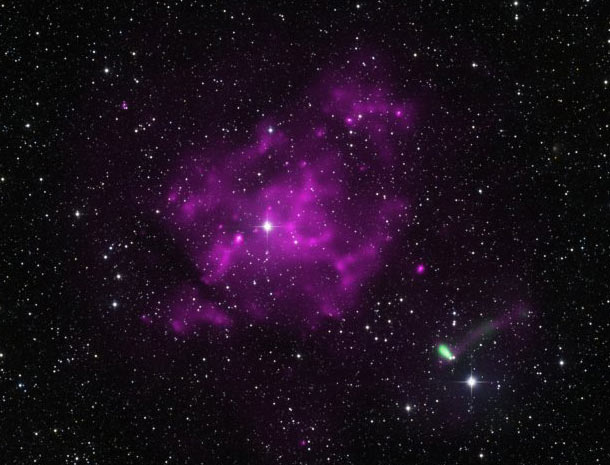Create a free profile to get unlimited access to exclusive videos, sweepstakes, and more!
Cannonball star blasts away from the scene of the crime

When I picture an exploding star in my head -- which I do unsurprisingly often -- the imaginary mental detonation I picture is symmetric. That is, it expands like a sphere, getting bigger in all directions equally.
Supernovae are actually not like that though. Stars are messy affairs, and when massive ones explode they tend to have internal factors that distort that nice, smooth expansion. One big factor is that the actual point of explosion is off-center in the star, not at its exact heart. That can create a massively asymmetric explosion, blasting vast amounts of material and energy off to one side.
Mind you, the core itself in such a star still collapses to become a super-dense neutron star (or a black hole), but the sideways nature of the explosion can give a kick to the leftover ball of neutrons. Quite a kick. In fact, the energies are so titanic that an off-center supernova explosion can blast the neutron star in the other direction, screaming away from the explosion site like a shell out of the muzzle of a battleship gun.
And now astronomers may have found the most extreme example of this: what looks to be just such a neutron star barreling away from a supernova at high speed:
[Click to Chandrasekharenate.]
This image is a combination of observations from the XMM-Newton and Chandra X-ray observatories, the Digitized Sky Survey, and the 2MASS infrared survey. It shows the supernova remnant SNR MSH 11-16A, located about 30,000 light years away. The purple glow is from X-rays emitted by the gas superheated to millions of degrees by the exposion.
 But look off to the right. See that comet-looking thing? I've put a close up of it here. You can see a dot at the head of the "comet": astronomers think that might be the runaway neutron star from the explosion that created SNR MSH 11-16A! It's hard to know for sure, but a lot of things add up to make me think they're right.
But look off to the right. See that comet-looking thing? I've put a close up of it here. You can see a dot at the head of the "comet": astronomers think that might be the runaway neutron star from the explosion that created SNR MSH 11-16A! It's hard to know for sure, but a lot of things add up to make me think they're right.
The most obvious is that tail of gas pointing right back to the center of the supernova gas cloud. A hot, young neutron star blows out a high-energy wind of subatomic particles called a pulsar wind, and that pushes against gas floating out in space. As a runaway neutron star blasts through space, it would leave a glowing trail like that. The X-rays appear to be coming from a single, tiny point, just what you'd expect for a neutron star, and observations using optical and infrared don't see it; again, just what you'd expect since neutron stars are tiny and don't glow visibly. They're brightest in X-rays due to their phenomenally strong magnetic fields whipping particles around at high energies.
The fainter tail to the side is something of a mystery, though. Apparently things like this have been seen before, but it's not clear what's causing it.
Knowing the distance to the supernova remnant we can get its size, which, together with its expansion rate, tells us that it's something like 15,000 years old. If that dot is the ejected neutron star, it's screaming away from the explosion site at a mind-numbing 10 million kilometers per hour (6 million mph) -- fast enough to cross the entire United State in two seconds flat! Yegads.
Other runaway neutron stars have been seen moving away from supernovae at high speeds, but none this fast. Again, this has not been confirmed to be the neutron star in question, but if it is, it handily holds the speed record for such an event. Mind you, this star probably has about the mass of the Sun: over an octillion tons!
Can I get another "yegads" from the congregation?
Images like this show me that my mental images of some phenomena need to be updated. We like to simplify in our heads, and that's fine if it helps us get a grip, a basic understanding, of a complex event. But we have to remember that the Universe is weird and complex and sometimes gleefully bent on crushing our preconceptions. That might make some people uncomfortable, but it fills me with joy. Who wants a boring Universe where we easily understand everything?
Weirdness is way more fun.
Image credit: X-ray: NASA/CXC/UC Berkeley/J.Tomsick et al & ESA/XMM-Newton, Optical: DSS; IR: 2MASS/UMass/IPAC-Caltech/NASA/NSF
Related Posts:
- Rampaging cannonball star is rampaging
- Runaway star
- The Crab is still crabby
- Shocking star is shocking. Shocking, I say!















